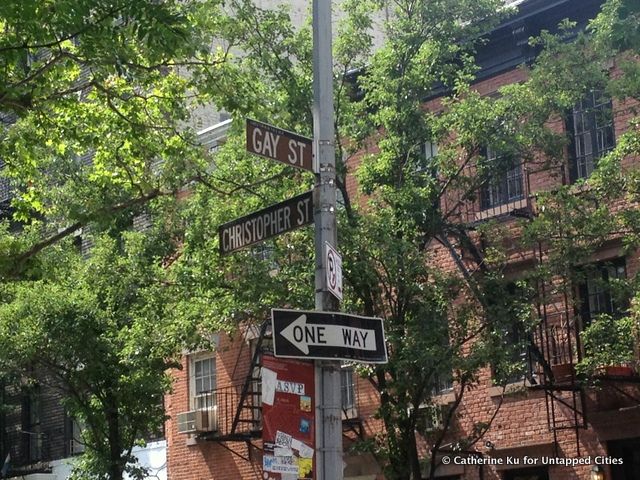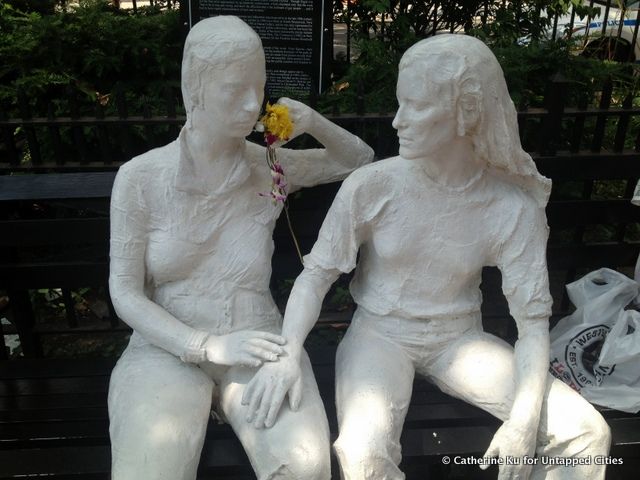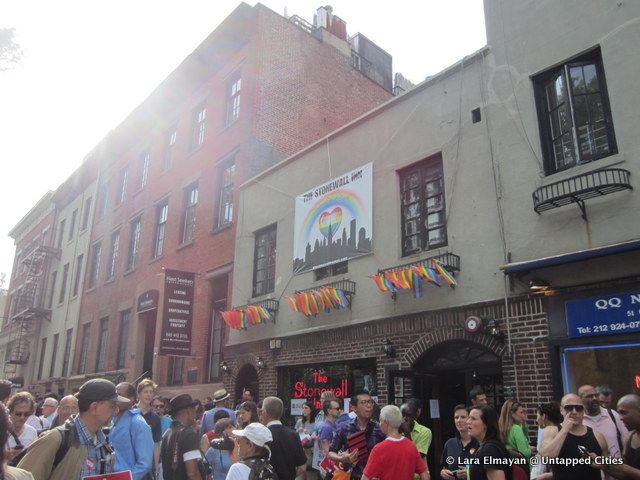Artist-Led Tour of "ENCORE" Photo Exhibit w/ Mark S. Kornbluth
Join photographer Mark S. Kornbluth for a visual exploration of NYC's Broadway theaters at Cavalier Galleries!


In a new book, Safe Space, the author Christina Hanhardt asserts that the 2002 Greenwich Village rally, “Take Back Our Streets” was not antigay but racial, classist and gender normative. To Hanhardt, the complaints aired by the Greenwich Village neighborhood coalition and the arc of the mainstream LGBT antiviolence movement have been “strikingly alike.” She embarked on a mission to chronicle the inextricably entwined histories of the LGBT rights movement and the American post-industrial city, both histories in which violence has played a significant role.
On May 6, 2002, residents, business owners and politicians staged the“Take Back Our Streets” in Christopher Park, across the street from the Stonewall Inn. The rally aimed to call attention to neighborhood noise, loitering, and other low-level offenses that were the target of Mayor Giuliani’s famed anticrime campaign. The primary focus was the Hudson River piers that had become a preferred hangout for gay black and Latino youths after similar crackdowns ousted them from Washington Square Park.
Ill at ease in their own neighborhoods, gay black and Latino New Yorkers sought out the community and anonymity afforded by historically gay enclaves like Greenwich Village. The wealthy, mostly white, but avowedly liberal Village residents who complained of quality of life infringements were appalled that their stance was seen as antigay. Indeed there are still many gays among them, although they are mostly white men who are relatively well-off. But gay residents were silent on the issue, or even in support of the neighborhood groups, and no major LGBT rights groups came to the aid of the targeted youths.
Stonewall, which in the 1960s was the country’s largest gay establishment, was tacitly hospitable to prostitutes, drug dealers and transvestites, groups that were shunned by other local gay bars at the time. In fact many “mainstream” lesbians and gay men distanced themselves from the famous riot of 1969 because of the role played by these marginal groups. Post-riot, the reputation of Greenwich Village as a gay enclave grew, as more and more gay-owned and -oriented businesses sprouted up there. More recently, gentrification and zoning restrictions against adult uses have forced the closure of many of these, but the neighborhood’s old reputation lives on.
It is impossible to study the postwar urban phenomenon of gentrification without looking at the role of the LGBT community. Since the flight to the suburbs and the coincident decline of the urban core, safety within the city center became a shared goal between urban property owners and the social minorities who remained. This was a tenuous coalition however, and during the ’70s and ’80s urban minorities were at best ignored and at worst incarcerated. By contrast, popular political and academic discourse maintains that gays “hold the key for the rejuvenation of struggling metropolitan areas.” Their assessed degree of safety in their new central city homes is used as a gauge of a city’s prosperity: if such a vulnerable group can feel safe there, it is deemed an urban success story. But at the same time, the delineation and protection of gay urban space has deepened race and class divides in the contemporary city.
Beginning in the 1970s, the gay urban ghetto was held up by the mainstream LGBT movement as the ultimate safe space, a respite from suffocating small towns and uniform suburbs. The 1998 murder of Matthew Shepard in Laramie, Wyoming was a chilling picture of the intolerances that were purportedly endemic between the two coasts. Meanwhile, modern boosters of the city contend that proximity of disparate groups make the city vibrant, dynamic and tolerant. But by also cloistering itself from the inconvenient realities of urban poverty, the gay neighborhood also made itself an obvious target for bias crime.

In May of this year, Mark Carson, a gay black man from Brooklyn, was shot point-blank on West 8th Street in the Village by a man shouting antigay slurs. Victims of antigay violence (many black and Latino) in the 21st century are in part victims of the success of their (mostly white) 20th century LGBT activist forebears. But as Hanhardt points out, early supporters of the gay neighborhood were somewhat conscious of the commingled risks. Indeed the location of a crime (gay neighborhood or not) and the identity of the accused (gay or not) are the two criteria the justice system has developed to determine whether crimes are based on antigay bias.
In the weeks following Mark Carson’s murder, the press attributed the rash of antigay violence in gay-friendly neighborhoods to a push-back against growing institutional acceptance of gays (i.e. the shockingly rapid and widespread uptake of laws allowing same-sex marriage). Feeling voiceless at the ballot box, homophobes take their convictions into their own hands. But Hanhardt is not so sure. She’s convinced crime, the reporting of crime, and media coverage of crime all move in their own strange patterns, patterns that are hard to predict and even harder to correlate with one another. So perhaps the press covers antigay violence at times when it believes there is public appetite for gay stories, such as when gay marriage is on the upswing.
For as long as the industrial city has existed, Western cultural thought has blamed the city for a perceived moral decline and an increase in vice – sexual non-normativity included. But gays are not the only community conflated with the city in our collective imagination. So too are blacks. “Urban” and “inner-city” have long been used as synonyms for black Americans. But the history of gay activism has seen repeated attempts to distance homosexuality from other vices and crimes associated with the city, specifically those affiliated with black poverty. By the time urban crime was spiraling seemingly out of control in the 1980s, gays and lesbians were painting themselves as victims, not perpetrators. Even in 2008, Hanhardt reminds us, several white gay observers blamed the black vote for the passage of Proposition 8 in California, a bill, since deemed unconstitutional, that disallowed same-sex marriage.

Today, the American city is not quite as, ahem, black and white. The TV show “Modern Family” normalizes the gay family (along with the multiracial family) by situating it in the stereotypically white, hetero suburb. This is potentially helpful, but definitely more and more true; the suburbs have diversified both ethnically and sexually as blacks and Latinos have sought refuge from urban violence and migrated toward jobs, and gay and lesbian families have sought yards and better schools. These are all of course the same reasons that middle-class straight white families began the march to the suburbs over a half-century ago.
Back in the city, the original gayborhoods are among the most exclusive in town, and gentrification moves ever outward. Thanks to a variety of factors, including safety, tolerance, and even hook-up apps, gays don’t quite feel the need to cluster together in urban ghettos as much anymore. They should be grateful they have the choice.
Read more from the book Safe Space.
Subscribe to our newsletter